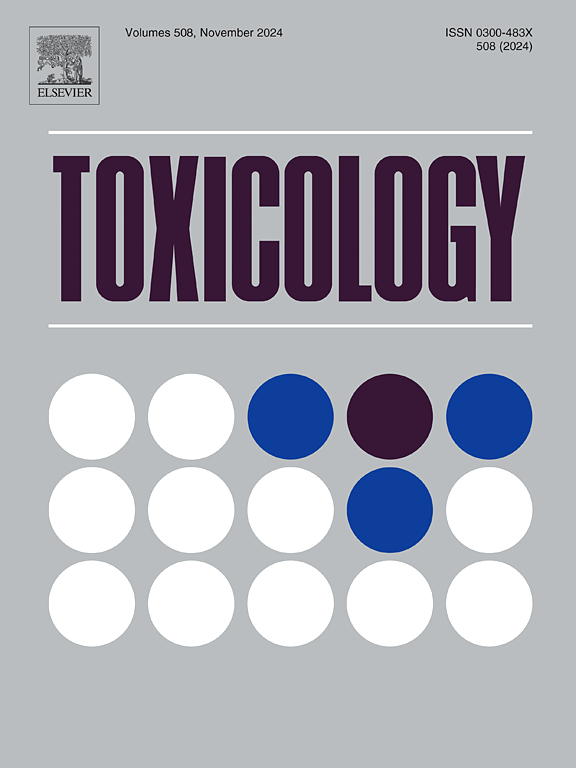A high-throughput microphysiological system to quantify key events leading to liver fibrosis
IF 4.6
3区 医学
Q1 PHARMACOLOGY & PHARMACY
引用次数: 0
Abstract
New approach methodologies (NAMs), including microphysiological systems (MPS), are emerging as alternatives to animal testing. In the liver, chronic hepatocellular damage can progress to fibrosis, which has been described by an Adverse Outcome Pathway (AOP). However, standardized in vitro models that capture and quantify key AOP events and cell-cell interactions are lacking. We developed a scalable liver fibrosis model using the 384-well Akura™ Twin microplate featuring 168 interconnected well pairs. We studied fibrosis progression by seeding HepaRG microtissues (MTs), with or without THP-1 cells in alpha wells and hepatic stellate cell (hTERT-HSC) MTs in beta wells. Cell health and metabolic activity were monitored via specific sensors that detect glucose and lactate levels. Transforming growth factor beta 1 (TGF-β1), methotrexate (MTX) and acetaminophen (APAP) reduced albumin production, indicating hepatocellular injury. TGF-β1 activated THP-1, increasing ALOX5AP, TREM2, and TGF-β1 mRNA expression. PAI-1 protein levels increased following treatment with TGF-β1, particularly in HepaRG-THP-1 co-cultures. In hTERT-HSCs, TGF-β1 also induced expression of fibrosis markers (ACTA2, COL1A1, COL3A1 and FN1) and increased stress fibers and fibronectin expression. Extracellular matrix remodeling was confirmed by elevated Pro-Collagen 1A1 and CTGF protein levels upon TGF-β1 treatment. The Akura™ Twin platform enables high-throughput modeling of liver fibrosis, mimicking the key events of the liver fibrosis AOP. This model, combining a high-throughput MPS with established cell lines, offers a promising tool to investigate fibrosis mechanisms and advancing quantitative AOP development. Journal: Toxicology (Special Issue: Hepatotoxicity: mechanisms and animal-free prediction models).
高通量微生理系统量化导致肝纤维化的关键事件。
新的方法方法(NAMs),包括微生理系统(MPS),正在成为动物试验的替代品。在肝脏中,慢性肝细胞损伤可进展为纤维化,这已被描述为不良结局途径(AOP)。然而,缺乏捕获和量化关键AOP事件和细胞-细胞相互作用的标准化体外模型。我们使用384孔Akura™Twin微孔板开发了一种可扩展的肝纤维化模型,该微孔板具有168个相互连接的孔对。我们通过在α孔中植入或不植入THP-1细胞的HepaRG微组织(MTs)和在β孔中植入肝星状细胞(hTERT-HSC) MTs来研究纤维化进展。通过检测葡萄糖和乳酸水平的特定传感器监测细胞健康和代谢活动。转化生长因子β1 (TGF-β1)、甲氨蝶呤(MTX)和对乙酰氨基酚(APAP)降低白蛋白生成,提示肝细胞损伤。TGF-β1激活THP-1,增加ALOX5AP、TREM2和TGF-β1 mRNA的表达。TGF-β1治疗后PAI-1蛋白水平升高,特别是在HepaRG-THP-1共培养中。在htert - hsc中,TGF-β1还诱导了纤维化标志物(ACTA2、COL1A1、COL3A1和FN1)的表达,并增加了应激纤维和纤维连接蛋白的表达。TGF-β1治疗后,前胶原蛋白1A1和CTGF蛋白水平升高,证实了细胞外基质重塑。Akura™Twin平台可实现肝纤维化的高通量建模,模拟肝纤维化AOP的关键事件。该模型将高通量MPS与已建立的细胞系相结合,为研究纤维化机制和推进定量AOP开发提供了一个有前途的工具。杂志:毒理学(特刊:肝毒性:机制和无动物预测模型)。
本文章由计算机程序翻译,如有差异,请以英文原文为准。
求助全文
约1分钟内获得全文
求助全文
来源期刊

Toxicology
医学-毒理学
CiteScore
7.80
自引率
4.40%
发文量
222
审稿时长
23 days
期刊介绍:
Toxicology is an international, peer-reviewed journal that publishes only the highest quality original scientific research and critical reviews describing hypothesis-based investigations into mechanisms of toxicity associated with exposures to xenobiotic chemicals, particularly as it relates to human health. In this respect "mechanisms" is defined on both the macro (e.g. physiological, biological, kinetic, species, sex, etc.) and molecular (genomic, transcriptomic, metabolic, etc.) scale. Emphasis is placed on findings that identify novel hazards and that can be extrapolated to exposures and mechanisms that are relevant to estimating human risk. Toxicology also publishes brief communications, personal commentaries and opinion articles, as well as concise expert reviews on contemporary topics. All research and review articles published in Toxicology are subject to rigorous peer review. Authors are asked to contact the Editor-in-Chief prior to submitting review articles or commentaries for consideration for publication in Toxicology.
 求助内容:
求助内容: 应助结果提醒方式:
应助结果提醒方式:


